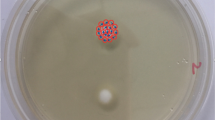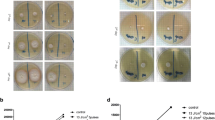Abstract
The effects of various laser wavelengths and fluences on the fungal isolate, Trichophyton rubrum, were examined in vitro. Standard-size isolates of T. rubrum were irradiated by using various laser systems. Colony areas were compared for growth inhibition on days 1, 3, and 6 after laser irradiation. Statistically significant growth inhibition of T. rubrum was detected in colonies treated with the 1,064-nm Q-switched Nd:YAG laser at 4 and 8 J/cm2 and 532-nm Q-switched Nd:YAG laser at 8 J/cm2. Q-switched Nd:YAG laser at 532- and 1,064-nm wavelengths produced significant inhibitory effect upon the fungal isolate T. rubrum in this in vitro study. However, more in vitro and in vivo studies are necessary to investigate if lasers would have a potential use in the treatment of fungal infections of skin and its adnexa.


Similar content being viewed by others
References
Arenas R, Dominguez-Cherit J, Fernandez LM (1995) Open randomized comparison of itraconazole versus terbinafine in onychomycosis. Int J Dermatol 34:138–143
Aly R, Hay RJ, Del Palacio A, Galimberti R (2000) Epidemiology of tinea capitis. Med Mycol 38:183–188
Aman S, Haroon TS, Hussain I, Bokhari MA, Khurshid K (2001) Tinea unguium in Lahore, Pakistan. Med Mycol 39:177–180
Elewsk BE (2000) Tinea capitis: a current perspective. J Am Acad Dermatol 42:1–20
Evans EG (1998) Causative pathogens in onychomycosis and the possibility of treatment resistance: a review. J Am Acad Dermatol 38:S32–S36
Nweze EI (2001) Etiology of dermatophytoses amongst children in northeastern Nigeria. Med Mycol 39:181–184
Lesher JL Jr (1999) Oral therapy of common superficial fungal infections of the skin. J Am Acad Dermatol 40(6 pt 2):S31–S34
Koehler AM, Maibach HI (2001) Electronic monitoring in medication adherence measurement. Implications for dermatology. Am J Clin Dermatol 2:7–12
Scher RK (1999) Onychomycosis: therapeutic update. J Am Acad Dermatol 40(6 Pt 2):S21–S26
Elewski BE (2000) Onychomycosis. Treatment, quality of life, and economic issues. Am J Clin Dermatol 1:19–26
Joish VN, Armstrong EP (2001) Which antifungal agent for onychomycosis? A pharmacoeconomic analysis. Pharmacoeconomics 19:983–1002
Kamp H, Tietz HJ, Lutz M, Piazena H, Sowyrda P, Lademann J, Blume-Peytavi U (2005) Antifungal effect of 5-aminolevulinic acid PDT in trichophyton rubrum. Mycoses 48:101–107
Smijs TG, van der Haas RN, Lugtenburg J, Liu Y, de Jong RL, Schuitmaker HJ (2004) Photodynamic treatment of the dermatophyte trichophyton rubrum and its microconidia with porphyrin photosensitizers. Photochem Photobiol 80:197–202
Smijs TG, Schuitmaker HJ (2003) Photodynamic inactivation of the dermatophyte Trichophyton rubrum. Photochem Photobiol 77:556–560
Tanzi EL, Lupton JR, Alster TS (2003) Lasers in dermatology: four decades of progress. J Am Acad Dermatol 49:1–31
Keates RH, Drago PC, Rothchild EJ (1988) Effect of excimer laser on microbiological organisms. Ophthalmic Surg 19:715–718
Ouf SA, Abdel-Hady NF (1999) Influence of He–Ne laser irradiation of soybean seeds on seed mycoflora, growth, nodulation, and resistance to Fusarium solani. Folia Microbiol 44:388–396
Antony FC, Harland CC (2001) Red ink tattoo reactions: successful treatment with the Q-switched 532 nm Nd:YAG laser. Br J Dermatol 149:94–98
Gupta AK, Ahmad I, Borst I, Summebrbell RC (2000) Detection of xanthomegnin in epidermal materials infected with Trichophyton rubrum. J Invest Dermatol 115:901–905
Van Gemert MJ, Welch AJ, Pickering JW, Tan OT, Gijsbers GH (1995) Wavelengths for laser treatment of port wine stains and telangiectasia. Laser Surg Med 16:147–155
Bjerring P, Christiansen K, Troilius A (2003) Intense pulsed light source for the treatment of dye laser resistant port-wine stains. J Cosmet Laser Ther 5:7–13
Raulin C, Greve B, Grema H (2003) IPL Technology: a review. Laser Surg Med 32:78–87
Shafirstein G, Baumler W, Lapidoth M, Ferguson S, North PE, Waner M (2004) A new mathematical approach to the diffusion approximation theory for selective photothermolysis modeling and its implication in laser treatment of port-wine stains. Laser Surg Med 34:335–347
Wu-Yuan CD, Hashimoto T (1977) Architecture and chemistry of microconidial walls of trichophyton mentagrophytes. J Bacteriol 129:1584–1592
Hashimoto T, Wu-Yuan CD, Blumenthal HJ (1976) Isolation and characterization of the rodlet layer of Trichophyton mentagrophytes microconidial wall. J Bacteriol 127:1543–1549
Suthamjariya K, Farinelli WA, Koh W, Anderson RR (2004) Mechanisms of microvascular response to laser pulses. J Invest Dermatol 122:518–525
Alster TS (1999) Cutaneous resurfacing with CO2 and erbium: YAG lasers: preoperative, intraoperative and postoperative considerations. Plast Reconstr Surg 103:619–632
Author information
Authors and Affiliations
Corresponding author
Rights and permissions
About this article
Cite this article
Vural, E., Winfield, H.L., Shingleton, A.W. et al. The effects of laser irradiation on Trichophyton rubrum growth. Lasers Med Sci 23, 349–353 (2008). https://doi.org/10.1007/s10103-007-0492-4
Received:
Accepted:
Published:
Issue Date:
DOI: https://doi.org/10.1007/s10103-007-0492-4




